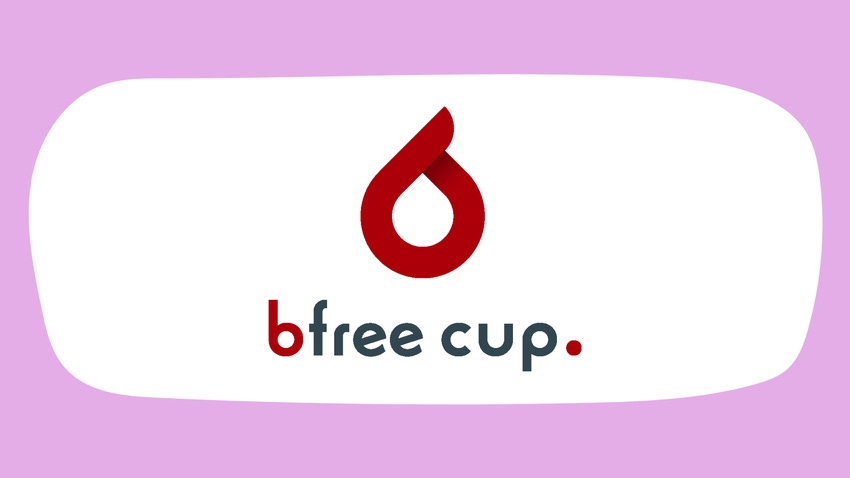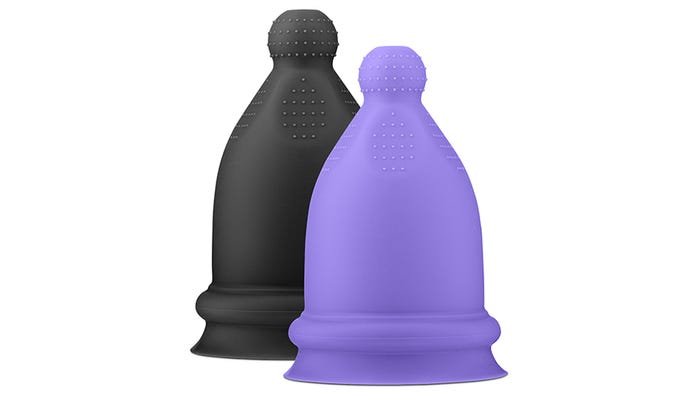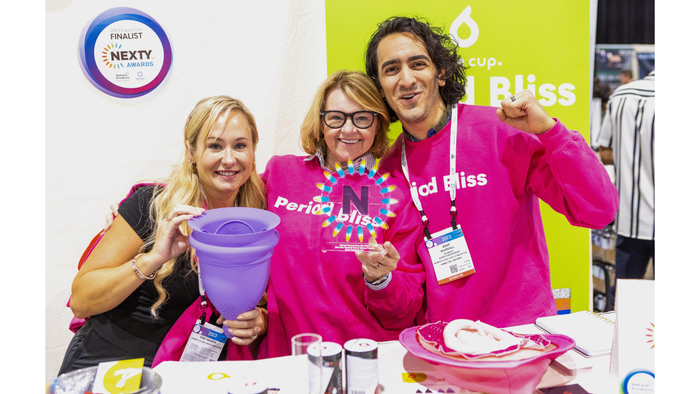NEXTY Award winner Bfree tackles period poverty sustainably
Once Leisa Hirtz learned about the hardships menstruating women face in vulnerable communities, she set out to change the world. Find out how she did it.
December 19, 2023

For way too long, menstruation has been stigmatized, deemed too personal for polite conversation and considered a monthly “problem” to be dealt with quietly. Along with robbing women and girls of education and support, this outdated social construct has created a marketplace that offers very few product choices for managing a period. And in some regions of the world, they don’t even have the options we take for granted in most of North America.
Appalled by the inequities, Canadian product developer, researcher and entrepreneur Leisa Hirtz vowed to create change. She founded Women’s Global Health Innovations in 2013 to study menstrual and reproductive health, specifically examining period poverty among refugees in Uganda and in vulnerable communities in Kenya. While she was learning about the obstacles these people faced in managing their periods in a sanitary and dignified way, Hirtz realized that women and girls everywhere experience many of the same challenges.
After several years of intense R&D, Women’s Global Health Innovations launched the Bfree Cup, offering a sustainable, cost-effective, healthy and safe solution for period management. Made of high-quality silicone, Bfree is 100% physically antibacterial, meaning it can be simply wiped clean, no boiling required—a game-changing innovation that enables widespread adoption.
To help close the accessibility gap, WGHI partners with global organizations to distribute the Bfree Cup and engender entrepreneurship around it. Applauding its innovation and mission, New Hope Network awarded Bfree the NEXTY Award for Best New Personal Care or Beauty Product at Natural Products Expo East 2023.
We sat down with Hirtz to learn more about her company’s genesis, impact and growth.

What led you to launch WGHI and eventually Bfree?
Leisa Hirtz: I come from a science, public health and product-development background, and I started really looking at menstruation and the taboos around it. Coming from a feminist perspective and looking at what’s holding women back from equal pay and opportunities, I’ve always thought it’s because we have periods—and isn’t that strange?!
So in the early 2000s, I started asking, where is the innovation in menstrual products? We were still looking at the same old products on-shelf. There was no real innovation in materials, the reality being that the big multinationals didn’t have to change anything because people were still buying these products. But then the market started asking questions, like, is this really all we have?
And many women around the world had even fewer—if any—choices, right?
LH: I was seeing period poverty in low- and middle-income countries—the realities of adolescent girls and women, the indignities of not being able to manage their period. I learned stories of sitting in the sand for five days or using old socks or animal skins. Even when they had opportunities to go to school, they couldn’t because they didn’t have access to products, due mainly to the unaffordability of products.
But beyond the dignity implications, there are health implications too. And the taboo and shame around menstruation is a global phenomenon—why? This is a normal, healthy, bodily function related to reproduction. Desiring to see global gender equality, and thinking we’ll never see [that] if we don’t have menstrual equity, that was the genesis of “Let’s see what we can do here.”
Why did you pursue a menstrual cup versus other product formats?
LH: At that time, menstrual cups were starting to be taken up as an alternative method from health food stores. There was a buzz, with people saying, “Wow, this really changed my life.” That’s a big statement to make. We also saw menstrual cups starting to be distributed in urban slums and refugee settlements, and people were saying, “Wow, this is really making a difference.” But those cups needed to be boiled as a standard cleaning protocol, so uptake would inevitably be met with restrictions and [therefore] be slow and limited. So this became the challenge for me: Let’s make a menstrual cup that doesn’t need to be boiled.
Well, you certainly had the product development experience to do it!
LH: I studied at Ontario College of Art and Design, and from a fabrication perspective, it was about understanding molds and industrial processes, so I had the formal education and background. Then in the early 2000s, I was in product development, working in silicone with biomechanical engineers in prosthetics devices. I loved silicone and wanted to continue working this dynamic and inert material.
Then in 2014, after founding WGHI, we received funding from Ontario Centre of Innovation. We did some early testing to determine whether a technology coming out of Harvard could be transferable to medical-grade silicone. Could we create a silicone with surface properties that would prevent a biofilm from forming? Essentially, could we create a menstrual cup that is 100% physically antibacterial and super hydrophobic, that users could just wipe clean, without the need to boil? We went into research and achieved proof of concept.
What happened next?
LH: We won funding from Grand Challenges Canada, a Stars in Global Health award, to support our continued research. Research continued at ESPCI Paris, a French national research institution, until 2017. Science works very slowly, and of course, dealing with women’s health, we wanted the highest quality product.
So we achieved proof of concept, then created prototypes, then validated the product. Oftentimes the first prototype doesn’t work, so it’s back and forth until you get your minimum viable product. We made a few minor changes while looking at the four or five top menstrual cup brands on the market to see what challenges their users were having. Some cups leaked; some were difficult to insert or remove. I worked with mechanical engineers and physicists to design a better cup, and we came up with a distinctly Bfree Cup design.
Once we had our MVP, we asked, could we produce in high volume and do so economically? All of those questions that, as a product developer, it’s like, oof, this is overwhelming. But you take it one day at a time. We did a Kickstarter in 2018, and in 2019 we decided to take our MVP to market. Basically, we launched in 2020—ha, what a great year to go into business!

Bfree Menstrual Cups are available in Raven and Periwinkle.
How is the Bfree Cup different than competitors’ cups?
LH: Leaking is a common problem with most other menstrual cups. This is a pretty significant design issue. Our solution is an upper petal at the top. This petal adheres better to the walls of the vagina, creating a leak-free seal. Mechanical engineers helped us improve the mechanical forces to make sure it pops open more easily, so you don’t have to spin it around or pull it up and down to get it to open. And we put more silicone into our cup, so it’s thicker and higher quality.
While in product development, were you also building your social impact model?
LH: We won a global innovation award from the United Nations Population Fund in 2018. Through that, we went into Uganda and trained some 500 schoolgirls and boys on comprehensive menstrual and reproductive health. This is where we started developing our education program and leaning into a localized approach. As a social enterprise, we constantly seek innovative ways and expanded partnerships to deliver these products successfully.
From there, we received a competitive grant from the government of Canada called the Fund for Innovation and Transformation. This brought us back to Uganda in 2019 to implement another project. Here we tested a micro-entrepreneurial model to train women and some men to sell the product.
Oh, so you don’t just give cups away to communities in need—people buy them?
LH: When products are given away for free, we’re interrupting the potential for a market. I’d rather give a cup to a woman who will sell it in her community, who wants to run a business and is trained on micro-entrepreneurship or microfinancing. It creates a mutually beneficial opportunity. We are grateful to be welcomed, deliver training and collaborate to support women’s economic empowerment—because without economic empowerment, poverty is perpetuated.
Also, because the woman sells the products locally, she is there for questions and user support, as she is somebody whom they know and trust. This model is proving to be quite successful and one we wish to scale.

Leisa Hirtz, co-creator of the Bfree Menstrual Cup, and her team celebrate winning the 2023 Expo East NEXTY Award for Best New Personal Care or Beauty Product.
Wow, in less than four years in business, you’re already making a huge impact.
LH: We are riding a really positive wave right now. We have what I think is the most innovative menstrual cup that uses the least amount of water over any other period product. It’s wonderful hearing women say, “This has changed my life.” It also speaks to the fact that there is so much more room for innovation in menstrual products. We have other products in the pipeline, and we continue to research other materials. But the Bfree Cup is our first product and it’s really making a substantive impact.
We’ve reached about 30,000 users, many of whom live in refugee settlements and in low- and middle-income countries. In two schools we’re working with in Uganda, we had an extraordinary 90% uptake. But when girls are given five disposable pads to use over five months, you can understand why.
We also sell in the U.S. and are getting feedback like, “I’ve used other cups before, but finally, this one actually works. It doesn’t leak. I’m so confident in it.” I never get tired of hearing this. There are always a few who try it and say it’s just not for them, and that’s OK too. Overall, 90% to 95% of our feedback has been positive. I have many pinch-me moments when I realize this is really working!
This has been quite a journey so far—you must be proud.
LH: It has been a great journey, and that’s not to say that the entrepreneurial journey has been easy—it hasn’t. As a woman in business, a woman looking to disrupt this particular sector, a woman looking to attract investment, it has been challenging. We’ve got to always be out there pitching and talking to the right investors because we are a social enterprise and don’t want to compromise on our values.
What was it like to win a NEXTY Award?
LH: I am so appreciative of New Hope. Before Expo East, our team was like, “It’s really good that we’re a NEXTY finalist.” I said, “No, we’re winning!” They looked at me like I was crazy, like “You’re going to be let down.” And I’m like, “No, I’m going in with the attitude that we’re winning. We’ve got an amazing product, the time has come and I want to win so badly!” Then when they heard the dinging coming to our booth, it was like, “I told you!”
We were so tickled. It was watery eyes, feeling like yes, yes, yes! It just feels good to be recognized, and it’s validation that yes, this can really change lives. The proof is this NEXTY Award. Again, I still pinch myself that we are making a difference, and I don’t want to lose this feeling. We still have so many women to reach because there is opportunity for lives to be changed everywhere in the world.
About the Author(s)
You May Also Like




